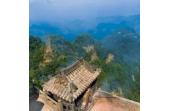Mount Wudang
- Things to do
-
- Photo(10)
- Tips&article(13)
- Make it Happen
- Map
-
loading...
- Other Tours
Wudang Mountain, also named Taihe Mountain and Canshang Mountain, stretches for 800 miles of spectacular scenery with secluded valleys and picturesque peaks. There are about 72 peaks, about 24 streams, about 11 caves, pools, and ponds. The main peak is called Tianzhu Peak and has an elevation of 1,612 meters. The other peaks surround it and the peaks and streams are a special sight.
Wudang Mountain is renowned for its magnificent architecture. The whole group of buildings exemplifies the Taoist ideal of “Zhenwu Training to be Immortal” with imperial architectural design laid out to match the surrounding landforms. Some buildings are built on the peaks of the high mountains, some are between cliffs and in valleys, and some are in forests in harmony with nature. In China, it is thought of as a place that exhibits the achievement of ancient Chinese architecture. In 1994, the ancient architecture group on Wudang Mountain was included in the UNESCO World Heritage List.
Wudang Moutain’s Major Attractions:
Xuanyue Gate:
Xuanyue Gate is the common name for “Zhishi Xuanyue” Memorial Arch.
It is a chiseled stone building with three rooms, four pillars and
five floors. It was built in the 31st year of the Jiajing Period in
the Ming Dynasty (1552 AD). It is 12 meters high and 12.8 meters
wide. Four Chinese characters “Zhishi Xunyue” (Govern the World,
Profound Name治世玄岳) that were written by Emperor Jiajing are carved
on a tablet.
Yuxu Palace:
Its full name is “Xuantian Yuxu Palace.” It was the biggest
building complex on Wudang Mountain. It was built in the 11th year
of the Yongle Period in the Ming Dynasty (1413 AD) and renovated in
the 31st year of the Jiajing Period (1552). The complex was built
with 2,200 temples or rooms. Most of them were damaged in the 10th
year of the Qianlong Period in the Qing Dynasty (1745 AD), so now
there are four.
Mozhen Jing Palace:
It is also named “Chunyang Palace.” It’s 12 kilometers south of
Laoying. The palace was first built during the Yongle Period in the
Ming Dynasty. The existing Mozhen Jing Palace was rebuilt in the
2nd year of the Xianfeng Period in the Qing Dynasty (1852 AD). In
the 1984, it was renovated to be almost the same as before. There
are over 50 rooms and a surface area of 1,700 square meters.
Taizi Po Palace:
It was built in the 10th year of the Yongle Period in the Ming
Dynasty (1412 AD). It is also called “Fuzhen Guan.” It was
renovated in the 1st year (1662 A.D), 23rd year, and the 29th year
of the Kangxi Period in the Qing Dynasty. It is now smaller than it
used to be, but it is still one of the larger building complexes.
South Rock Palace (Nanyan in Chinese):
It is said to be the “Taoist sacred ground” where Zhenwu attained
the way to fly and be immortal. People say that this South Rock
Palace area has the best scenery. It was renovated in the 11th year
of the Yongle Period in the Ming Dynasty (1413 AD). There are about
150 buildings such as palaces, housing for Taoists, temples and
pavilions. It has a tablet with the words “Dasheng Nanyan Palace.”
In the 31st year of the Jiajing Period (1552 AD), the palace was
enlarged. There were once 460 rooms. Stone Palace, Nantian Gate,
Stele Pavilion and Liangyi Palace still exist.
Qiongtai Guan Palace
It is southeast of Tianzhu peak and about ten kilometers from it.
It is at an elevation of 1,350 meters, and it has upper, middle and
lower sections. It was called “Qiongtai Palace” in the Yuan
Dynasty. Then during the Ming and Qing dynasties, it was renovated
and enlarged for 24 Tao sanctuaries and hundreds of temple rooms.
It was destroyed in the war of the 6th year of the Xianfeng Period
in the Qing Dynasty (1856 AD). Some of the temple rooms have been
restored. It is the starting point for a cable way for the Wudang
Mountain Scenic Area, so it has become a tourist tranport
center.
Zixiao Palace:
Built in the 11th year of the Yongle Period in the Ming Dynasty (AD
1413), it originally had more than 860 palaces, porticoes and
pavilions. There is a tablet with the words “Taiyuan Zixiao
Palace.” Zixiao Palace backs against Zhanqi Peak and faces Zhaobi,
Santai, Wulao, Lazhu, Luomao and Xianglu peaks. Leishen Cave, Yuji
Pool and Baozhu Peak are on either side. The title, “Zixiao Merry
Land,” was conferred on the area by Emperor Yongle of the Ming
Dynasty.
Golden Palace (Jin Palace):
This nationally protected site is at the top of Tianzhu Peak at an
elevation of 1612 meters. The Golden Palace was built in the 14th
year of the Yongle Period in the Ming Dynasty (1416 AD). Inside
there are three edifices that are 5.54 meters high, 4.4 meters long
and 3.15 meters wide. All of them are built with gilded bronze. It
is said to be a world masterpiece of copper architecture.
Wulong Palace (Wulong means Five Dragons):
Wulong Palace is beneath the Lingying Mountain peak. During the
Zhenguan Period in the Tang Dynasty (627-649), “Wulong Ancestral
Hall” was built by imperial order. In the 10th year of Yongle
Period in the Ming Dynasty (1412), about 215 temples, mountain
gates and other buildings were built. There were about 850 rooms or
buildings in the complex, but in 1930 this temple was also
destroyed by fire. There are many relics and remains.
Address: It is in the eastern side of Daba Mountain and is a part of
Danjiangkou City in the northwestern area of Hubei Province.
Special Distinction: It is a famous Taoist area, and is one of China’s best national
park areas, and is considered a world cultural heritage.
Tips & articles
|
|
|
forum discussion
|
|
|











